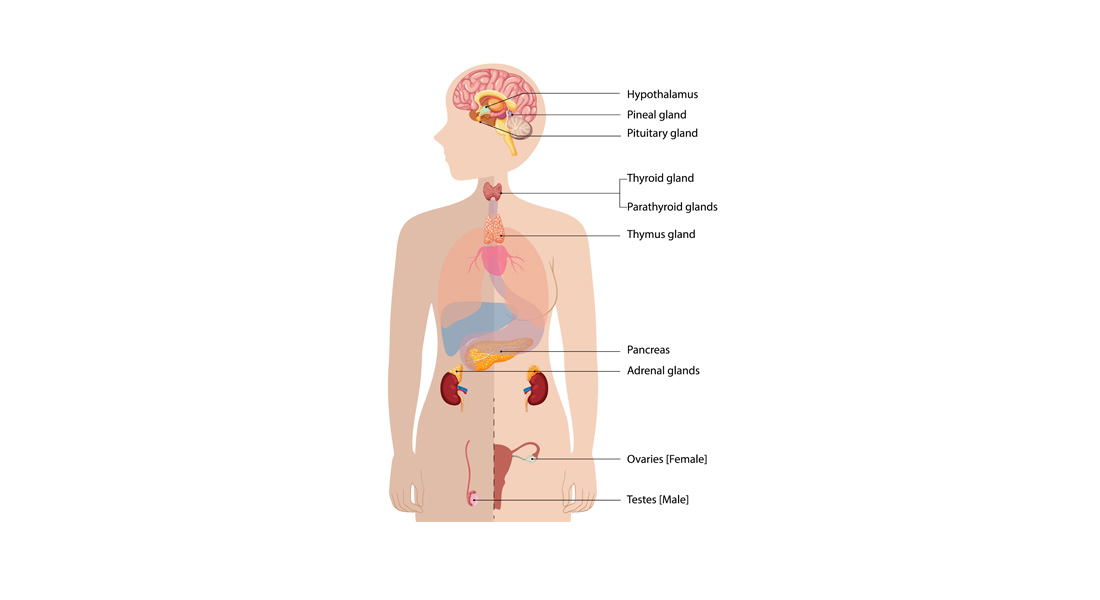The Endocrine System
The endocrine system, alongside the nervous system, plays a key role in regulating body functions, sending and receiving sensory information, and coordinating body responses. Together, they are referred to as the neuro-endocrine system.
Key Functions of the Endocrine System
-
The endocrine system regulates body activities by releasing hormones into the bloodstream, which carry signals throughout the body.
-
Hormonal responses can be instantaneous or may occur after several hours or days.
-
Hormones have diverse and wide-ranging effects on the body.
Hormone Functions
Hormones are chemical messengers that regulate various physiological activities, ensuring proper body functioning. Their roles include:
-
Regulating the chemical composition and volume of extracellular fluid (internal environment).
-
Controlling metabolism and energy balance.
-
Regulating muscle contractions and glandular secretions, especially smooth and cardiac muscle.
-
Maintaining homeostasis, even during disruptions like infection, trauma, dehydration, starvation, hemorrhage, and temperature fluctuations.
-
Supporting immune system activities.
-
Promoting growth and development, ensuring smooth and sequential processes.
-
Facilitating reproduction, including gamete production, fertilization, embryonic nourishment, delivery, and infant care.
Exocrine and Endocrine Glands
The body contains two types of glands:
1. Exocrine Glands
-
These glands secrete products into ducts, which carry substances to body cavities, the lumen of organs, or the body's surface.
-
Examples: Sudoriferous (sweat) glands, sebaceous (oil) glands, mucous glands, and digestive glands.
2. Endocrine Glands
-
Endocrine glands secrete hormones into the extracellular space, where they diffuse into the capillaries and are transported via the bloodstream.
-
Major Endocrine Glands:
-
Pituitary gland
-
Thyroid gland
-
Parathyroid glands
-
Adrenal glands
-
Pineal gland
-
Pancreatic islets
-
-
Other hormone-producing organs/tissues:
-
Hypothalamus, thymus, pancreas, ovaries, testes, kidneys, stomach, liver, small intestine, skin, heart, and placenta.
-
Hormones
-
Hormones are chemical substances that act as messengers, influencing specific actions within target cells.
-
Even in very low concentrations, hormones have powerful effects.
-
The human body produces approximately 50 different hormones.
-
The cells affected by specific hormones are called target cells.
-
Hormones bind to receptors on target cells to initiate their actions.
The Pituitary Gland and Hypothalamus
-
The pituitary gland (hypophysis) is attached to the hypothalamus at the brain's base.
-
The hypothalamus serves as the primary link between the nervous system and the endocrine system.
-
Together, the hypothalamus and pituitary gland regulate most aspects of growth, development, metabolism, and homeostasis.
Pituitary Gland Overview
-
It is about the size of a pea, weighs 500 mg, and consists of two main parts:
-
Anterior Pituitary (Adenohypophysis): An upgrowth of glandular tissue.
-
Posterior Pituitary (Neurohypophysis): A downgrowth of nervous tissue connected to the hypothalamus via nerve fibers.
-
Blood Supply to the Pituitary
-
Anterior Pituitary: Supplied indirectly via blood that passes through the hypothalamus.
-
Posterior Pituitary: Supplied directly by arterial branches of the internal carotid artery.
Role of the Hypothalamus
-
The hypothalamus regulates hormone release from both parts of the pituitary gland:
-
Anterior Pituitary: By producing releasing hormones (stimulate) and inhibiting hormones (suppress).
-
Posterior Pituitary: Stores and releases hormones produced in the hypothalamus.
-
Hormones of the Pituitary Gland
Posterior Pituitary Hormones
-
Antidiuretic Hormone (ADH): Retains body water, maintaining water balance.
-
Oxytocin (OT): Controls uterine contractions during labor and stimulates milk ejection during breastfeeding.
Anterior Pituitary Hormones
The anterior pituitary contains five principal cell types, which secrete seven major hormones:
-
Growth Hormone (GH)
-
Stimulates body growth, particularly bones and skeletal muscles.
-
Regulates metabolism in organs like the liver, pancreas, and intestines.
-
Secretion is influenced by GHRH (stimulates) and GHRIH (inhibits), and peaks during sleep and adolescence.
-
-
Thyroid Stimulating Hormone (TSH)
-
Stimulates thyroid gland activity and secretion of T3 (triiodothyronine) and T4 (thyroxine).
-
Regulated by Thyrotropin Releasing Hormone (TRH).
-
-
Adrenocorticotropic Hormone (ACTH)
-
Promotes synthesis and release of steroids from the adrenal cortex.
-
Controlled by Corticotropin Releasing Hormone (CRH).
-
-
Prolactin (PRL)
-
Prepares breasts for lactation and initiates milk production post-pregnancy.
-
Regulated by Prolactin Releasing Hormone (PRH) and Prolactin Inhibiting Hormone (PIH).
-
-
Gonadotropins
-
Follicle-Stimulating Hormone (FSH):
-
In Females: Stimulates ovarian follicle maturation and estrogen secretion.
-
In Males: Initiates spermatogenesis.
-
-
Luteinizing Hormone (LH):
-
In Females: Triggers ovulation, corpus luteum maintenance, and progesterone secretion.
-
In Males: Stimulates testosterone production.
-
-
-
Melanocyte-Stimulating Hormone (MSH)
-
Influences skin pigmentation.
-
Growth Hormone (GH)
-
Stimulates cell growth and division, particularly in bones and skeletal muscles.
-
Its release peaks during childhood and adolescence and is regulated by:
-
GHRH: Growth hormone-releasing hormone.
-
GHRIH (Somatostatin): Growth hormone-inhibiting hormone.
-
-
Secretion is influenced by sleep, exercise, and low blood glucose levels.



Free Videos